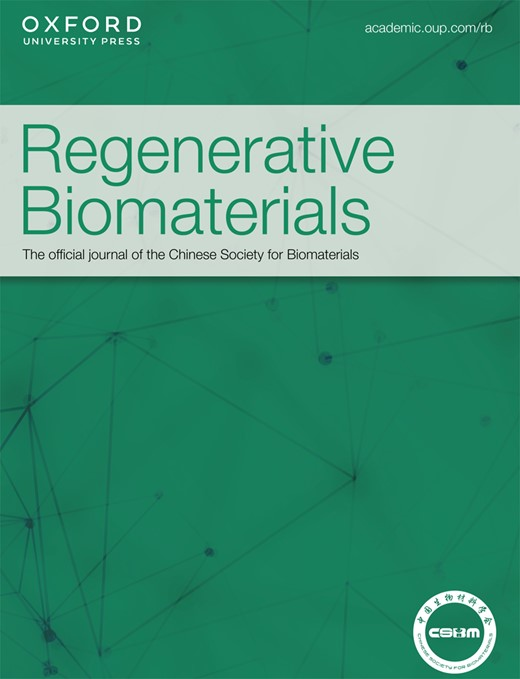将富含酪氨酸的三嵌段肽可控地自组装成坚固的胶原蛋白仿生生物支架,用于老化皮肤的再年轻化
IF 5.6
1区 医学
Q1 MATERIALS SCIENCE, BIOMATERIALS
引用次数: 0
摘要
皮肤衰老是一个复杂的生理过程,以皮肤结构和功能的改变为特征,严重影响着人类的生活。胶原蛋白在治疗皮肤老化方面具有相当大的潜力,但动物来源的胶原蛋白存在病原体传播的风险。自组装肽在创建胶原蛋白仿生材料方面受到越来越多的关注;然而,之前报道的自组装肽依赖于脆弱的非共价相互作用,或者缺乏控制形态和结合功能性图案的能力,从而限制了其模拟胶原蛋白结构和功能的能力。在此,我们创造了一种可控的富含酪氨酸的三嵌段肽系统,该系统能够自组装成坚固的胶原蛋白仿生生物支架,用于修复老化皮肤。通过钌介导的交联,这些肽能自我组装成定义明确的纳米球或胶原蛋白仿生支架,并由三重螺旋结构和酪氨酸分布进行精确调节。自组装的胶原蛋白仿生支架对各种溶剂和 pH 值条件具有出色的耐受性。整合素结合基团被整合到三重螺旋块中,不会破坏它们的组装,同时赋予它们卓越的生物活性,有效促进细胞粘附和增殖。体内研究表明,它们能加速胶原蛋白再生并激活成纤维细胞,从而有效治疗光老化皮肤。这种富含酪氨酸的自组装三嵌段肽是一种多功能系统,可用于制造坚固的胶原蛋白仿生生物材料,在皮肤年轻化和组织再生方面具有巨大潜力。本文章由计算机程序翻译,如有差异,请以英文原文为准。
Controllable self-assembly of tyrosine-rich triblock peptides into robust collagen mimetic bioscaffolds for aging skin rejuvenation
Skin aging, a complex physiological process characterized by alterations in skin structure and function, seriously affects human life. Collagen holds considerable potential in aging skin treatment, while animal-derived collagen poses risks of pathogen transmission. Self-assembled peptides have garnered increasing attention in creating collagen mimetic materials; however, previous reported self-assembled peptides rely on vulnerable non-covalent interactions or lack the capability of controlling morphology and incorporating functional motifs, limiting their ability to mimic collagen structure and function. We have herein created a controllable tyrosine-rich triblock peptide system capable of self-assembling into robust collagen mimetic bioscaffolds for rejuvenating aging skin. Through ruthenium-mediated crosslinking, these peptides self-assemble into well-defined nanospheres or collagen-mimetic scaffolds, precisely regulated by the triple-helical structure and tyrosine distribution. The self-assembled collagen mimetic scaffolds exhibit outstanding resistances to various solvents and pH conditions. The integrin-binding motif has been incorporated into the triple helical block without disrupting their assembly, while endowing them with superior bioactivities, effectively promoting cell adhesion and proliferation. In vivo studies demonstrated their efficacy in treating photoaging skin by accelerating collagen regeneration and activating fibroblasts. The self-assembled tyrosine-rich triblock peptides represent a versatile system for creating robust collagen mimetic biomaterials, providing great potential in skin rejuvenation and tissue regeneration.
求助全文
通过发布文献求助,成功后即可免费获取论文全文。
去求助
来源期刊

Regenerative Biomaterials
Materials Science-Biomaterials
CiteScore
7.90
自引率
16.40%
发文量
92
审稿时长
10 weeks
期刊介绍:
Regenerative Biomaterials is an international, interdisciplinary, peer-reviewed journal publishing the latest advances in biomaterials and regenerative medicine. The journal provides a forum for the publication of original research papers, reviews, clinical case reports, and commentaries on the topics relevant to the development of advanced regenerative biomaterials concerning novel regenerative technologies and therapeutic approaches for the regeneration and repair of damaged tissues and organs. The interactions of biomaterials with cells and tissue, especially with stem cells, will be of particular focus.
 求助内容:
求助内容: 应助结果提醒方式:
应助结果提醒方式:


